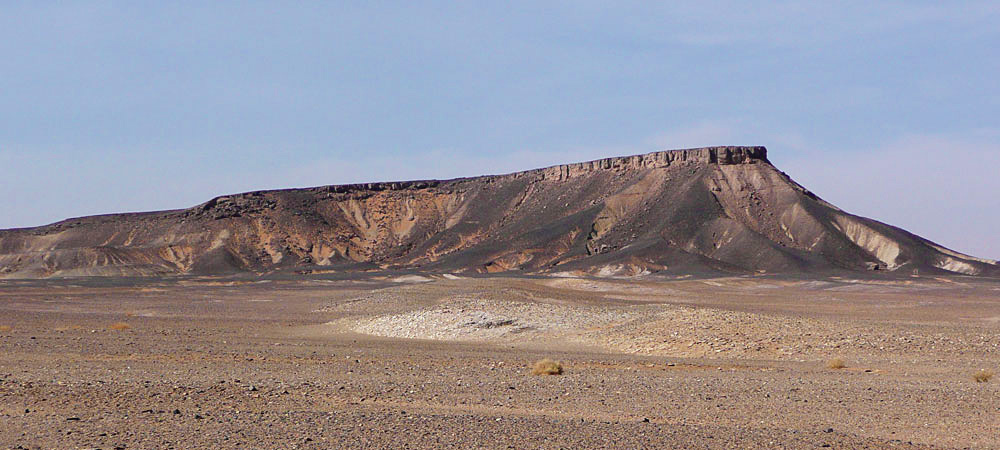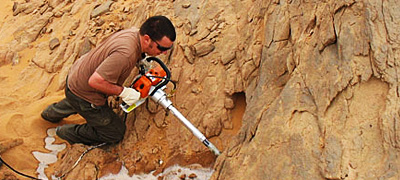Research in Libya
Libya had been an area of focus for a number of years. Research has included:
- Extensive fieldwork undertaken along the coastal margin, Jeffara Nefusa, and also inland along the Murzuq/ Ghadames Basin;
- Examining the Ordovician Memouniat Fm, Carboniferous Marar Fm and Early Cretaceous Messak Fm;
- Studies on the main Tannezuft source facies;
- Reservoir and source rock studies and basin modeling and diagenesis.
Current research focuses on using subsurface data, such as the ongoing PhD in the Sirt Basin (Kotla Graben).
Completed projects
This study was undertaken by Stefan Lubeseder, supervised by Prof Jonathan Redfern. The aim was to develop a third-order sequence stratigraphic framework for the Silurian and Devonianof North Africa, focusing on Morocco, Algeria, Tunisia and Libya. Due to the stability of the Saharan Craton during this period, Palaeozoic stratigraphy is relatively uniform across the area, allowing a regional study. Palaeozoic rocks form important reservoir and source rocks in North Africa, from the Cambrian to the Carboniferous. A sequence stratigraphic scheme together with the geometry of depositional systems and the key characteristics of their boundaries was developed, which offers as a valuable tool for the prediction of reservoir units in areas beyond data control. The outcrop studies can also serve as analogues to reservoir units in the subsurface. The final PhD thesis contain large inter-regional chronostratigraphic correlation charts, constructed to illustrate the intracratonic depositional model for North Africa.
Practically, the study was split into three parts:
Morocco field case study
Silurian: Silurian sections were studied in the Tafilalt area as well as in the Dra Plain of southern Morocco (Anti-Atlas). The emphasis was on the Ludlowian "Orthoceras" limestones and the so-called "Scyphocrinites" limestones at the Silurian/Devonian boundary. These limestone levels were studied in terms of their biostratigraphic position, depositional system, and inter-regional sequence stratigraphic significance. Silurian "Orthoceras" limestones are known from various other parts of the world and the study provided a significant contribution to the understanding of these beds.
Publications:
Lubeseder, S. (2008). Palaeozoic low-oxygen, high-latitude carbonates: Silurian and Lower Devonian nautiloid and scyphocrinoid limestones of the Anti-Atlas (Morocco). Palaeogeography, Palaeoclimatology, Palaeoecology, 264(1-2): 195-209
Lubeseder, S., Redfern, J., Boutib, L., (2009), Mixed siliciclastic-carbonate shelf sedimentation- Lower Devonian sequences of the SW Anti-Atlas, Morocco Source: Sedimentary Geology, 215, 1-4, pp. 13-32
Lubeseder S., J. Redfern, L. Petitpierre, S. Fröhlich. (2011). Stratigraphic trapping potential in the Carboniferous of North Africa: developing new play concepts based on integrated outcrop sedimentology and regional sequence stratigraphy (Morocco, Algeria, Libya). Geological Society, London, Petroleum Geology Conference series 2011, v. 7, p. 725-734, doi: 10.1144/?0070725
PhD Thesis:
Stefan Lubeseder 2005: Silurian and Devonian Sequence Stratigraphy of North Africa: Regional?Correlation and Sedimentology (Morocco, Algeria, Libya)
Depositional systems, stratigraphy and reservoir characterisation of the Early Cretaceous of Libya and Tunisia.
The project commenced in 2006 with a PhD undertaken by Mustafa Karer and supervised by Prof Jonathan Redfern, and was extended to include a field based study led by Dr Stephane Bodin and Prof Jonathan Redfern, with PhD student Jonathan Wood. This latter involved extensive fieldwork in the Murzuk Basin Libya and along the Jeffara Arch (Libya and Tunisa). The research involved collaboration with the LPI Libya and University of Sphax, Tunisia. Aims were to understand the evolving depositional systems, revise the stratigraphy /sequence stratigraphy and characterise /evaluate potential Early Cretaceous reservoirs. The study extended to the subsurface in the Sirt basin, where the "Nubian" sandstones are one of the main reservoir targets. This phase was completed in 2012, with a series of publications and the successful completion of Jonathan Wood's PhD. This project may be extended in future to incorporate further subsurface data, and extend to Egypt and the wider region.
The separate but linked project undertaken by Mustafa Karer (funded by the Libyan government / LPI, with data sponsored by Wintershall) examined the Nubian sandstone and associated igneous activity in the Hameimat Trough, Sirt Basin, Libya. The research utilized high-resolution 3D seismic data, combined with gravity, aeromagnetic, well data and cuttings samples. This project provides valuable insight into seismic imaging of intrusive and extrusive igneous events within the Nubian (Sarir Sandstone) in the Sirt basin, Libya. The presence of volcanics can prove a hazard to drilling, and of emplacement volcanics can have serious detrimental effects on reservoir volume and quality. A number of major oil fields in eastern Sirt basins produce from the Early Cretaceous Nubian sandstone. This significant reservoir is highly structured and has a poorly understood facies distribution. As drilling targets deeper reservoirs or more complex structural areas, developing a better understanding of the Nubian is crucial to successful future exploration. In some localities the Nubian contains significant interbedded volcanics, which have affected and often degraded reservoir quality. The volcanics also affect the seismic response and this makes the exploration program very challenging.
Publications:
Bodin, S., Wood, J., Petitpierre, L., Redfern, J. (2010). " Timing of Early to Mid-Cretaceous tectonic phases along North Africa: New insights from the Jeffara escarpment (Libya-Tunisia)." Journal of African Earth Sciences 58, 3. pp 489-506.
Wood, J.D., S. Bodin, J. Redfern, M.F.H. Thomas, (2014), Controls on facies evolution in low accommodation, continental-scale fluvio-paralic systems (Messak Fm, SW Libya), Sedimentology V 301 p49-69.
PhD Theses:
2009: Mustafa Karer (now with Haliburton Libya): Nubian Sandstones, Hameitmat Trough, Sirte Basin Libya, Evaluating the sedimentology, reservoir characteristics and distribution, and the interbedded igneous units, their origin, distribution and impact on reservoir quality. Libya Gov. Funded
2012 Jonathan Wood (now with Shell International): Sedimentological characterization and regional palaeo-environmental implications of the Messak Fm, SW Libya. NARG Sponsored
The project commenced in 2008 and was led by Dr Sebastian Frohlich (now at Statoil) and Prof Jonathan Redfern, with PhD student Laurent Petitpiere, following an earlier pilot study carried out by Dr Stefan Lubeseder. The project involved extensive fieldwork in Libya on the southern margin of the Ghadames Basin (in part supported by Woodside). Results provide valuable new insights into the depositional environments, and have identified a series of significant incised valleys in the Carboniferous, possible reservoir targets in the subsurface. The work addresses the underlying controls on the system, and refines outcrop to subsurface correlation. In future the project could be extended into the subsurface in Algeria, where these units may offer significant reservoir potential.
Publications:
Fröhlich S., J. Redfern, L. Petitpierre, J. Marshall, M. Power, P. Grech (2009), Diagenesis and reservoir quality evolution of Lower Carboniferous fluvial channels, western Libya) . Journal of Petroleum Geology
Fröhlich, S., Petitpierre, L., Redfern, J., Grech, P., Bodin, S., Lang, S. (2010). "Sedimentological and sequence stratigraphic analysis of Carboniferous deposits in western Libya: recording the sedimentary response of the northern Gondwana margin to climate and sealevel changes." Journal of African Earth Sciences 57 (4), pp. 279-296
Lubeseder S., J. Redfern, L. Petitpierre, S. Fröhlich. (2011). Stratigraphic trapping potential in the Carboniferous of North Africa: developing new play concepts based on integrated outcrop sedimentology and regional sequence stratigraphy (Morocco, Algeria, Libya). Geological Society, London, Petroleum Geology Conference series 2011, v. 7, p. 725-734, doi: 10.1144/?0070725
PhD Thesis:
2012 Laurent Petitpierre (now with Statoil): Sedimentology and Stratigraphy of the Early Carboniferous Marar Formation in Western Libya. NARG sponsored.
Reports: Preliminary Evaluation of the Carboniferous interval: Dr Stefan Lubeseder pilot study
This project undertaken by PhD student Gregg Pyke at Heriot Watt (now at Oxy) was supervised, Dr Andy Gardiner, Prof Patrick Corbett, and also Prof Jonathan Redfern, and examined the Controls on Reservoir Quality within the Cambro-Ordovician Sandstones of the Saharan Platform. Extensive fieldwork was been undertaken in the Murzuk Basin, integrated with a large subsurface dataset, built into a regional Petrel model. Diagenesis of the Memouniat reservoir has been modeled using the Touchstone software ™.
Publications:
No publications have been forthcoming from this work. A number of ppt presentations and extended abstracts are available on the NARG secure server.
PhD Thesis:
This work has still to be submitted for a PhD. A number of ppt presentations and preliminary reports are available to the sponsors.
The influence of dolomitisation on Late Cretaceous carbonates in North Africa is often critical to reservoir development. The study has analysed the superbly exposed section along the Jeffara escarpment of southern Tunisia, together with analogue outcrops in Northern Spain. These outcrops provide an excellent opportunity to study the extensively dolomitised Upper Albian-Lower Turonian shallow water carbonates of the Zebbag Formation (Rhadouane, Kerker and Gattar Members), and similar facies in Spain, which are potential outcrop analogues for reservoirs currently under production and appraisal in North Africa. This study comprised a multi-disciplinary, multi-scale approach using field, petrographical and geochemical data to better constrain the depositional history, diagenetic history and source of diagenetic fluids.
Publications:
3 papers in preparation.
PhD Thesis:
Richard Newport (2014), passed viva and currently undertaking minor correction prior to final submission. The thesis will be available in early 2015.
Associated (non NARG funded) projects
Mohammed Salem (2nd year) is funded by the Libyan Government, with data supplied by AGOCO:
The evolution of the Western Sirt Basin in the region of the Dahra Platform, Amin High and Kotla Graben is being evaluated by integrating 2D/ 3D seismic and data from 36 wells. Three tectonic styles can be identified involving regional Pre-rift intra-continental sag, complex multi-stage rifting and modification by wrenching. A major horst-graben system configuration has been delineated, which allows mapping fault distribution and timing throughout the area. Time, interval velocity, isochron, depth, isopach and lithofacies contour maps of the selected (12) horizons have been constructed. These maps are being used to interpret the subsurface architecture of the area from thickness, depth variations and velocity anomalies, in terms of tectonic effect and its control on thickness and facies distribution throughout the Dahra Platform and Kotla Graben area .
Lead researchers
Manchester:
- Prof Jonathan Redfern
- Dr David Hodgetts
- Dr Cathy Hollis
- Dr Stefan Schroeder
- Dr Mads Huuse
- Prof Kevin Taylor



